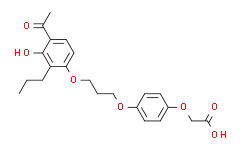| Description: |
L-165041 is a cell permeable PPARδ agonist, with Kis of 6 nM and appr 730 nM for PPARδ and PPARγ, respectively, and induces adipocyte differentiation in NIH-PPARδ cells. |
| Target: |
PPARδ:6 nM (Ki)
PPARγ:730 nM (Ki) |
| In Vivo: |
L-165041 (5 mg/kg/day, i.p.) significantly lowers the formation of lipid droplets in mice. L-165041 markedly reduces the level of both the hepatic cholesterol and triglycerides in mice. L-165041 increases mRNA expression levels of PPARδ compared to the vehicle group. Lipoprotein lipase (LPL) expression in L-165041-treated mice is significantly higher than that in the vehicle group[3]. |
| In Vitro: |
L-165041 is a PPARδ agonist, with Kis of 6 nM and appr 730 nM for PPARδ and PPARγ, respectively[1]. L-165041 (1 or 5 µM) inhibits VEGF-induced endothelial cells (ECs) proliferation and migration. L-165041 negatively affects cell cycle progression in VEGF-activated human umbilical vein ECs (HUVECs). L-165041 (10 µM)inhibits PPARδ-independent, VEGF-induced angiogenesis[2]. PPARδ ligand L-165041 inhibits PDGF-induced rVSMC proliferation and migration. With 1 h of L-165041 pretreatment, PDGF-induced cellular migration is inhibited. L-165041 (10 μM) significantly suppresses S phase transition induced by PDGF[4]. |
| Cell Assay: |
Human umbilical vein ECs (HUVECs) are cultured in EGM-2. Subconfluent HUVECs are made quiescent by serum starvation [EBM-2 containing 0.1% fetal bovine serum (FBS)] for 4 h. The cells are pretreated with the PPARδ ligand L-165041 or GW501516 for 6 h followed by VEGF (10 ng/mL) induction[2]. |
| Animal Administration: |
LDLR−/− mice are divided into vehicle (0.1 N NaOH) and L-165041 (5 mg/kg/day) group (9 animals in each group). LDLR−/− mice receive either NaOH or L-165041 via daily intraperitoneal injection (i.p.) for 16 weeks with the Western diet. Body weight is measured once a week and the blood samples for a serum parameter analysis are collected using an eye-bleeding method every 4 weeks. At the end of the experiment, LDLR−/− mice are fasted for 24 h before sacrificed and the liver samples are either fixed in formalin or frozen at −70°C for further analysis. All animals are housed in polycarbonate cages in a room with a 12-h light/12-h dark cycle, and maintained at a constant temperature of 22°C[3]. |
| References: |
[1]. Berger J, et al. Novel peroxisome proliferator-activated receptor (PPAR) gamma and PPARdelta ligands produce distinct biological effects. J Biol Chem. 1999 Mar 5;274(10):6718-25.
[2]. Park, Jin-Hee., et al. The PPARδ ligand L-165041 inhibits vegf-induced angiogenesis, but the antiangiogenic effect is not related to PPARδ. Journal of Cellular Biochemistry (2012), 113(6), 1947-1954.
[3]. Lim, Hyun-Joung., et al. PPARδ ligand L-165041 ameliorates Western diet-induced hepatic lipid accumulation and inflammation in LDLR-/- mice. European Journal of Pharmacology (2009), 622(1-3), 45-51.
[4]. Lim, Hyun-Joung., et al. PPARδ agonist L-165041 inhibits rat vascular smooth muscle cell proliferation and migration via inhibition of cell cycle. Atherosclerosis (Amsterdam, Netherlands) (2009), 202(2), 446-454. |






















